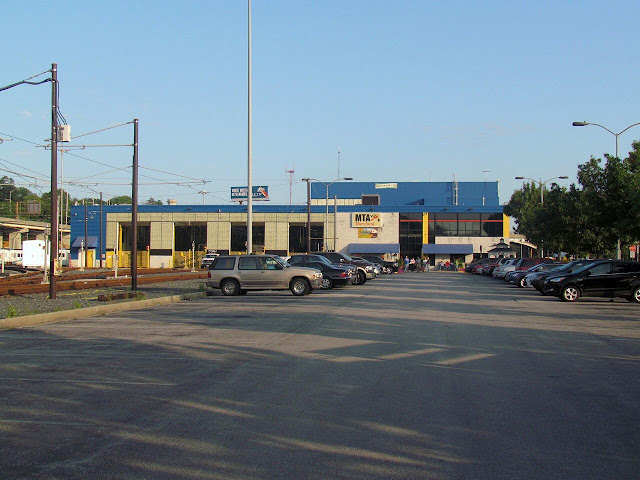The full gallery covering both tour stops can be found here, but for the sake of space this post will confine itself to the Light Rail shoppes.
Although I lived in walking distance, access to the facility was possible only by vehicle. However after getting picked up at the North Ave Light Rail stop, I was driven by a Baltimore Chapter member to the shoppe facility.
Our tour guide was a project manager for the Light Rail system and was currently working on some of their capitol improvements, most notably the rebuilding of the entire 1992 vintage LRV fleet.
After getting some special VIP day passes, we entered the shoppe where car #5034 in a Frutopia wrap had just entered while a Maryland Flag wrapped car was up on a lift in an adjacent bay.
Each LRV had three trucks, although only the end trucks are powered. Propulsion is AC and these were one of the first transit vehicles in North America with AC drive. Here we see one of the AC traction motors and a disc brake assembly, which is common to all three trucks.
Here we see a space truck, ready to be installed. The truck frames were fabricated by an outfit in Ohio and every axle had a single inboard disc brake assembly, even on the unpowered trucks.
Here we see a lineup of fresh axles, all with discs and a few with a gearbox assembly for the motor.
Like all transit shopped there was a giant lathe capable of turning axles and other cylindrical components.
Although we did not tour the dispatch office, there was a dispatch workstation located in the Yardmasters office right off the shop floor. Here we see a power dispatch screen to the left and a CTC model board on the right.
Here we see the North Ave Yard. Due to the location of the old railroad bulk transfer facility to the north the yard is single ended and movements heading north of the facility need to make a backup move in the North Ave station pocket track.
Here we see a pair of Scharfenberg couplers that have become popular with light rail systems across Europe and North America.
The LRV's are powered by GTO inverters, an early AC drive technology that has since been completely superseded by IGBT's. These will likely be replace during the overhaul.
Like all good shoppes there were stacks of spare wheels and bearings just laying around.
Truck turntables were provided so that the trucks could be rolled out from under an LRV and they pivoted 90 degrees to be rolled into the truck maintenance and assembly area that I previously covered.
The shoppe was well lit by skylights, here providing illumination to #5051 which is in the second generation "wave" paint scheme, which is not being replaced with Maryland Flag and various advertising wraps.
LRV #5054 here is shown up on the hydraulic lifts with its trucks removed.
The shoppe also has its own wheel mill to true wheels that have developed flat spots or other defects.
inside shot of LRV's #5006 and #5045.
Out behind the shoppe building, tucked way back in the yard was an old Conrail caboose! Man I really miss big blue.
One of the shoppe tracks was devoted to housing the car washer. I assume it was in working order, but given budgets these days one can never be too sure :-\
1-2 car LRV sets stored nose to nose in the yard. The yard uses a new axle counter system to give the yardmaster a precise idea of how much room is available in each storage track.
Some broader views of the storage yard. Doors are left open to facilitate car cleaning and to keep the heat levels down. Note the new Maryland flag scheme to go along with the Baltimore Link branding.
Group shot of the tour next to LRV #5039. Our guide was explaining how the LRV bodies were actually made from carbon steel and removal of the paint and vinyl wrapping often exposes major body rot issues. This is one of the many things the overhaul will try to address.
View of the south shoppe bay doors with the administrative offices on the east side of the building.
Travel to the Metro shoppes were going to be by...transit! What else? As a special treat the entire tour group shuffled down to the employee stop to flag down the next passing train. There were so many people in the tour that it was quite difficult for off of us to fit on the platform!!
Well that's it for Part 1. Tune in next time as we head out on the Metro Rail to examine the Baltimore Budds up close and personal!




























No comments:
Post a Comment